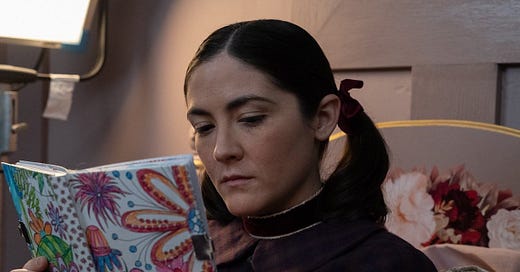‘Orphan: First Kill’ Review
The return of Esther, the most delightfully trashy horror queen of the last two decades.
I remember the electricity in the audience the first time I saw the biggest surprise of 2009, Orphan. One of those late-summer, early-fall horror films that slots nicely into the August doldrums, Orphan was pitched to audiences a bit like a gender-swapped version of the Macaulay Culkin/Elijah Wood vehicle, The Good Son: a girl is adopted by a loving family and then starts tormenting said family because, as the tagline put it, “There’s something wrong with Esther.”
Simple enough, and stylishly shot by Jaume Collet-Serra (who would go on to become the muse of late-stage Liam Neeson, directing Non-Stop, Run All Night, and The Commuter and helms this October’s Black Adam). We were all having a pretty good time watching Esther run roughshod over Kate (Vera Farmiga), adoption minder Sister Abigail (CCH Pounder), and everyone else onscreen—and then, all of a sudden, we were having a great time. Sudden gusts of shocked and stifled guffaws as we all in unison realized things were about to get weird.
Weird as in, the movie that we thought was about a little girl killing people is actually about a psychotic grifter dwarf who is posing as a little girl and trying to seduce the husband of the family in order to replace the mother. Weird as in, “Well that took a turn I didn’t see coming, hope it pays off.”
Reader, I assure you, it did. The movie, as a whole, was just okay—a little long for a picture of this sort at 2-plus hours—but that reveal went over like gangbusters.
Esther (Isabelle Fuhrman) is back in Orphan: First Kill, a prequel documenting—you guessed it—events hinted at in Orphan. We see Esther before she was Esther, back when she was Leena and living in an Estonian psychiatric institute. Following her bloody escape from those environs, she impersonates a missing American girl and is happily “reunited” with her mother, the uber-WASP Tricia (Julia Stiles), and her depressed father, Allen (Rossif Sutherland).
Esther’s return sparks joy, but also worry. Is she who she says she is? What of this accent she has acquired over the last four years? Why doesn’t she recognize her psychiatrist’s bird? (“All macaws are parrots but not all parrots are macaws,” her mother coolly informs her.) Why is she so fascinated by Allen’s painting studio when she never cared about his work before?
At first, Orphan: First Kill feels a bit like a retread, one of those prequels that does nothing more than fill in the gaps and explain certain tics from the original film. Were you ever curious about Esther’s penchant for using UV-visible paints in the first movie? Well I’ve got good news for you! And it looks like a straight-to-DVD sequel of a medium-sized hit (more on that in a moment), so it’s no surprise that it’s coming directly to Paramount+ and VOD this weekend rather than hitting theaters.
That said, there’s a twist in this movie that’s every bit as bonkers as the one that came before it, one that could have sent the film spinning off into silliness—and maybe even does, a little—but is so remarkably entertaining that it just works. It helps that Stiles remains one of the best and most underused talents in Hollywood, able to turn on a dime from warm-but-concerned to icily matriarchal. I would’ve enjoyed experiencing the second half of this movie with a paid audience like I did the first.

Update: I've heard from some folks who said it looked fine on Paramount+, so it sounds like the section below is more or less moot. Still might be worth the distributor checking in on the screener app to see what went wrong.
But this movie really can’t play in theaters. At least, it can’t play in theaters in the form that I saw it, via a critics-only streaming app. Set aside the relative stinginess of certain, unavoidable things endemic to a low-budget horror flick—computer-generated fire during a climactic set piece, say, or the fake blood splatters in the opening escape sequence—and you’re still left with a film that I can only describe as looking as though it had some sort of motion-smoothing effect turned on.
I am hesitant to blame director William Brent Bell or cinematographer Karim Hussain for this, as the vagaries of technology mean that there are any number of points at which this unfortunate error could have been introduced: the frame rate of the digital file uploaded to the streaming service, perhaps, or the streaming service’s own settings. It wasn’t my television (I double-checked to ensure that my children hadn’t accidentally turned motion-smoothing back on) and the effect replicated on my laptop. Additionally, when I asked a fellow critic if he’d had something similar happen, he confirmed that not only had he experienced it, he had heard from three other critics who had also experienced it.
Whatever the cause, the whole thing looked like it was shot in high frame rate, creating the dreaded “soap opera effect” anyone who saw the first Hobbit movie in the HFR format will remember. I hate to linger on this, as it may well simply be a snafu that only critics will have to deal with. But all I can judge is what I see, and the final result, to my eyes, enhanced the negative effects of the film’s modest budget: It just didn’t look like a proper theatrical film. It looked cheap and slightly amateurish, the difference between "modestly budgeted but fun" and "fun but unwatchably cheap." I will be curious to see how it looks for everyone else on Paramount+.





